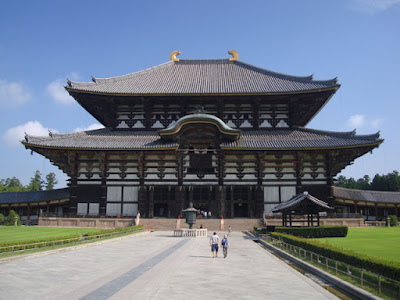Deers were considered sacred animals and were allowed to wander around the temples in Nara.

The majestic main hall of Tōdai-ji, the most famous Buddhist temple in Nara.

The statue of Buddha Vairocana inside the main hall of Tōdai-ji.

It was said that people would be blessed after climbing through this hole at the base of a pillar inside the main hall.

Nigatsudo was part of the Tōdai-ji complex and was constructed on a slope.

View of the Tōdai-ji complex and the city of Nara from Nigatsudo.

Visitors entering the Tōdai-ji complex through the southern gate.

Kasuga-taisha was the most famous Shinto shires in Nara.

Thousands of lanterns were consecrated to Kasuga-taisha.

A quiet corner at Kasuga-taisha.

For some reasons, the Nara National Museum was built in western style.

The main hall and five story pagoda of Kōfuku-ji.

Reconstruction has begun for the central main hall of Kōfuku-ji.

There was also a three store pagoda in Kōfuku-ji .

The tea Congee bendo served at a tea house near Kōfuku-ji was bitter but delicious.

iPod Touch was adapted as the personal electrical guide of the Heijō Palace.

Replica of the ship used by the missions to Tang China during the Nara Era.

It appeared the lanterns I saw last night were laid on the square every evening.

The bushes marked the locations where pillars of long gone buildings stood.

Archeological diggings underway at the site of the Heijō Palace.

Royals and nobles used to have summer evening banquets in this garden.

The Next Day